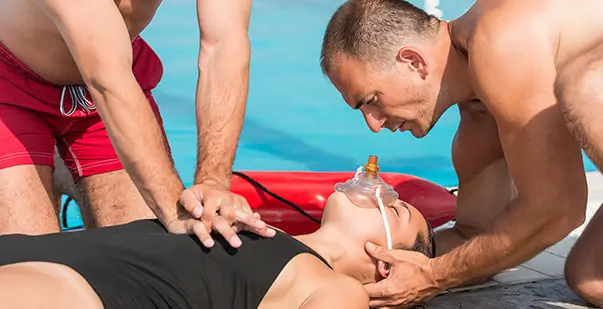
Last Updated On: September 9, 2024
Lifeguards and pool staff play a crucial role in maintaining the safety of swimming pools. However, accidents can happen even in the safest settings, and being prepared for an emergency is crucial.
Cardiac arrests are more common than we think, and every second counts when someone’s life is in danger. This is why lifeguard CPR training is essential since they are the first responders in these emergencies.
The American CPR Care Association offers exceptional online courses for obtaining CPR certification for adults, children, and infants. They are highly regarded on both a national and international level, ensuring top-quality training for individuals seeking certification.
Also, our courses are designed to meet the needs of various community protectors in schools, communities, and workplaces.
When you register with the American CPR Care Association, you will gain access to superior training and certification that strictly adheres to rigorous standards. Rest assured that choosing our organization ensures that you receive exceptional training and certification.
In this blog, we will discuss the importance of CPR training for lifeguards, how to administer CPR in a pool, and what to do if a swimmer goes into cardiac arrest.
Drowning is one of the leading causes of death worldwide, and it can occur anywhere, even in swimming pools that are supposed to be safe. The primary duty of lifeguards is to guarantee the safety of individuals swimming in the pool.
However, accidents can occur, and lifeguards must be equipped with crucial skills such as CPR where drowning is a real risk.
CPR training for lifeguards and pool staff equips them with the necessary skills to recognize, assess, and respond to a medical emergency promptly. Enroll in our lifeguard training courses offered by the American CPR Care Association, which can be taken right from the comfort of your home.
Performing CPR in a pool requires some additional steps compared to performing CPR on land. The procedure for performing CPR in a pool is as follows:
The first step is to transfer the victim in distress out of the water onto a solid surface. This is necessary as CPR cannot be performed effectively in the water.
Check for the victim’s responsiveness and breathing, tap their hands, and ask if they are okay. If there is no response, then check for breathing. Be alert and check for signs of breathing. If there is no breathing, start CPR.
If other people are around, instruct them to call 911.
Rest the victim on their back on a firm surface. Kneel next to their body and perform chest compressions. The depth of compressions should be at least 2 inches and at a rate of 100–120 compressions per minute. After 30 compressions, take two breaths by lifting the chin and tilting the head back.
5. Use an AED if available
If there is an AED available, switch it on and follow the instructions given by the device. Follow the prompts to administer a shock, if necessary. Resume CPR immediately after administering the shock.
6. Continue CPR
Continue performing CPR until help arrives or the victim begins to breathe on their own. Only stop CPR if the victim starts breathing and has a pulse.
If a swimmer goes into cardiac arrest, lifeguards must act quickly and respond promptly. These are the steps to be taken:
Evaluate the situation to determine the appropriate response. Check the swimmers’ vital signs, such as breathing and pulse.
If CPR is necessary, call for help or instruct someone to call 911. Inform them of the location, until then you can ask for help from people nearby.
Begin performing CPR while waiting for emergency responders to arrive. CPR must be carried out as soon as possible because every second counts. If there is an AED available, then use it.
After administering CPR to a cardiac arrest victim in a pool, quickly relay the victim’s vital statistics, including their pulse, breathing status, and level of consciousness, to the arriving EMT for effective medical intervention.
CPR certification program is vital for lifeguards and pool staff to respond effectively in an emergency. When you are well-trained in CPR, you have the power to save lives every time. To establish a secure swimming environment, it’s essential to become a certified lifeguard. Enroll in an online CPR course with us by visiting the American CPR Care Association website today.